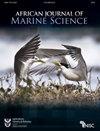Reproductive biology of the lesser African threadfin Galeoides decadactylus in Gabon, Gulf of Guinea
IF 1.4
4区 生物学
Q3 MARINE & FRESHWATER BIOLOGY
引用次数: 0
Abstract
The lesser African threadfin Galeoides decadactylus (family Polynemidae) is one of the most captured marine fish species in Central Africa. This study examines aspects of the reproductive biology of G. decadactylus in the Libreville area of Gabon. Fish caught with encircling gillnets and bottom gillnets were collected from May 2017 to May 2018 from artisanal fishermen. A total of 776 specimens were studied, comprising 401 females (14–36 cm total length [TL]), 347 males (13–28 cm TL), and 28 individuals of indeterminate sex (12–16 cm TL). Monthly monitoring of gonadosomatic ratio, condition factor and sexual maturity stages revealed that G. decadactylus reproduces continuously but has two slight peak periods: one in the long rainy season and the other in the short rainy season. The species is protandrous, with sizes at first sexual maturity of 17.7 cm TL for males and 18.7 cm for females. Mature individuals largely dominated the catches of small-scale fishers in Gabon. Mean absolute fecundity of females was 179 447 (SD 107 240) oocytes, and mean relative fecundity was 848 (SD 323) oocytes g–1. This study provides fisheries managers with crucial knowledge, such as size at sexual maturity, that could be used as a basis for sustainable management of G. decadactylus stocks in Gabon using minimum size limits.几内亚湾加蓬非洲小丝虫的生殖生物学
非洲小丝鱼Galeoides decadactylus(科丝鱼科)是中非捕获最多的海洋鱼类之一。本研究考察了加蓬利伯维尔地区的G. decadactylus的生殖生物学方面。2017年5月至2018年5月,从手工渔民那里收集了用环刺网和底刺网捕获的鱼。共研究776只,其中雌性401只(全长14 ~ 36 cm),雄性347只(全长13 ~ 28 cm),性别不确定28只(全长12 ~ 16 cm)。月间性腺比值、条件因子和性成熟期监测结果显示,黄鳝连续繁殖,但有长雨季和短雨季两个轻微高峰期。该物种雌雄同体,初次性成熟时雄性体长17.7 cm,雌性体长18.7 cm。在加蓬,成熟个体在小规模渔民的捕捞中占主导地位。雌性的平均绝对繁殖力为179 447 (SD 107 240)个卵母细胞,平均相对繁殖力为848 (SD 323)个卵母细胞g-1。这项研究为渔业管理人员提供了关键的知识,例如性成熟时的大小,这些知识可以作为利用最小大小限制对加蓬的十年鳗种群进行可持续管理的基础。
本文章由计算机程序翻译,如有差异,请以英文原文为准。
求助全文
约1分钟内获得全文
求助全文
来源期刊

African Journal of Marine Science
生物-海洋与淡水生物学
CiteScore
2.60
自引率
16.70%
发文量
17
审稿时长
6-12 weeks
期刊介绍:
The African (formerly South African) Journal of Marine Science provides an international forum for the publication of original scientific contributions or critical reviews, involving oceanic, shelf or estuarine waters, inclusive of oceanography, studies of organisms and their habitats, and aquaculture. Papers on the conservation and management of living resources, relevant social science and governance, or new techniques, are all welcomed, as are those that integrate different disciplines. Priority will be given to rigorous, question-driven research, rather than descriptive research. Contributions from African waters, including the Southern Ocean, are particularly encouraged, although not to the exclusion of those from elsewhere that have relevance to the African context. Submissions may take the form of a paper or a short communication. The journal aims to achieve a balanced representation of subject areas but also publishes proceedings of symposia in dedicated issues, as well as guest-edited suites on thematic topics in regular issues.
 求助内容:
求助内容: 应助结果提醒方式:
应助结果提醒方式:


